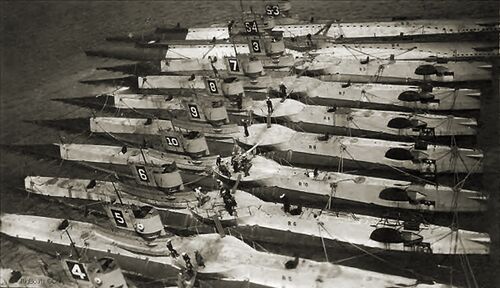R-class

Design and Construction Notes

The illustration at left is by artist and historian Jim Christley, done exclusively for PigBoats.COM. It shows the general, as built configuration of the EB design for the R-class. The Lake design for this class differed extensively (see below).
The legal provisions of the WWI era construction programs forced the Navy to accept all of the warships that had been contracted for construction during that time. After the war ended, the Navy found itself with more ships than it felt it needed for peacetime operations so scores of ships and submarines were laid up in reserve. The Lake design R-boats were all sent to Philadelphia for inactivation after only about five years of service. They were destined to be scrapped in the early 1930's to keep the USN in compliance with the London Naval Treaty. That same treaty forced the USN to lay up many of the EB design R-boats in 1930-1931. However, the EB design boats were retained, and most were reactivated for service as WWII kicked off in Europe. Several of these boats served in WWII as stateside training submarines. None made war patrols in the Pacific, although a few made anti U-boat patrols in the Caribbean. USS R-12 (SS-89) was lost on June 12, 1943 off Key West due to hull failure. There were just five survivors. The rest of the crew are "on eternal patrol".
The class is broken down by groups below.R-1 through R-14 (EB design built at Bethlehem Quincy)

R-15 through R-20 (EB design built at Bethlehem San Francisco)

BSF launched their boats with much of the superstructure and the conning tower fairwater yet to be installed, and with a false bow that was later replaced with the permanent one prior to completion. This is in marked contrast to the Bethlehem Quincy (BQ) yard near Boston (previously known as Fore River Shipbuilding) that built their group of R-boats with most of the superstructure complete and the conning tower fairwater in place. The cylindrical ribbed tower in the center of each boat is the pressure proof conning tower itself, used as a periscope station for making submerged attacks. Later in the construction phase a sheet steel fairwater would be built around the conning tower to provide a smooth flow of water around the tower, to provide a bridge for the Officer of the Deck and lookouts while surfaced, and to provide supports for the periscopes.
The docks on both sides of the submarines are stacked with huge amounts of materials for ship construction. BSF was also building destroyers and civilian merchant ships at this time and much of this material may be for those ships, as some of it is too large for submarines. What looks like huge sheets of cork insulation are stacked near the center of the photograph. This was applied to the interior of the pressure hull to help control the temperature of the interior of the boat. It was also to prevent condensation from dripping all over the crew and equipment causing discomfort and electrical shorts and grounds. There are also piping unions, elbows, and junctions stacked around seemingly by the hundreds.R-21 through R-27 (Lake design built at Lake Torpedo Boat Company)

General R-class group photos.

Page created by:
Ric Hedman & David Johnston
1999 - 2023 - PigBoats.COM©
Mountlake Terrace, WA, Norfolk, VA
webmaster at pigboats dot com